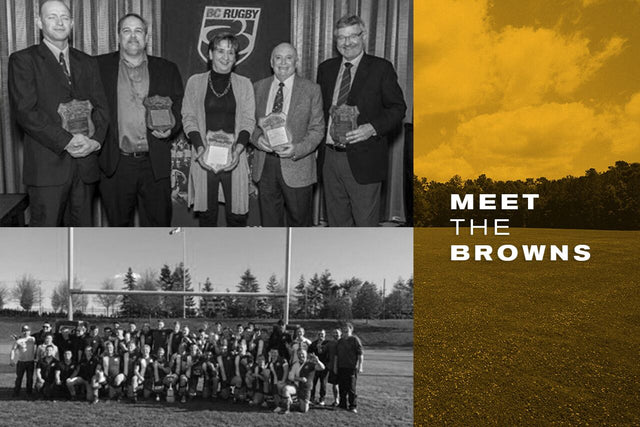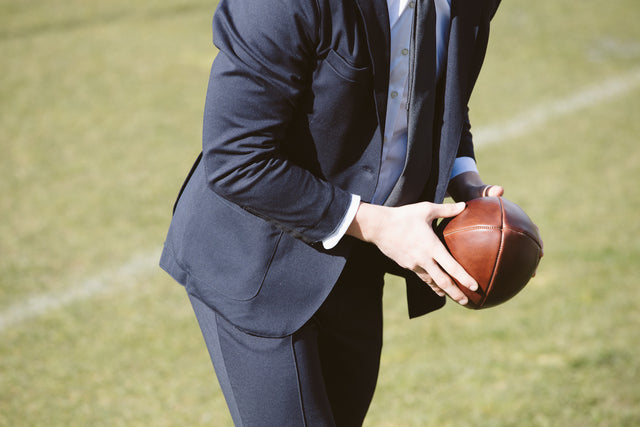Meet the Browns: Builders within the Canadian Rugby Community
Written By: Adam McQueen
For those that are unfamiliar with rugby, their questions about the game often extend beyond the puzzled looks when first seeing a maul or witnessing a giant of a man thrust into the air to retrieve a lineout. Instead, there are far more inquiries about the culture that revolves around the sport.
My uninitiated friends are befuddled that opponents share dinner and beer with one another after a match. They are enamoured by the number of old boys and women that don the timeless cotton jerseys of their club from decades past, filling the sidelines come rain or shine. Why do all these people, both young and old, hang around the clubhouse socializing hours after the final whistle has been blown?
Sure, the sadistic desire to physically smash your body into the opposition every Saturday becomes an addictive ritual. Yes, the feeling of winning after exhausting yourself for eighty minutes is insatiable. And of course, the first sip of a frosty pint as you sit flummoxed in your locker room with the tape that held you together in tatters by your feet is the epitome of pure bliss.
But why do people stay involved with rugby after they hang up the boots?
Take it from Dave Brown and Ruth Hellerud-Brown, the couple that have pioneered growing the game throughout Canada as both players and coaches - the allure of rugby transcends what happens within the confines of either touchline. The sport builds a community and your contributions only just begin once your playing days are over.
There is a huge level of camaraderie for sure,” notes Ruth. “I mean, it is so unique that you actually socialize with teams that you play against. You want to stay a part of the sport.”
Ruth Hellerud-Brown’s fingerprints are etched across women’s rugby within Canada at the domestic and international level. Her exploits as both a player and coach drove the development of the women’s game. Between 1984 and 1993, Hellerud-Brown represented Alberta, Saskatchewan, and British Columbia as a player in National Championships. She also continued to coach the British Columbia team until 1997, earning a national title in the process.
Ruth’s position as a player and managerial role often overlapped. As a member of the inaugural Canadian Women’s Team in 1987, she also assumed the role of Manager for their first test matches. Unheard of in today’s era, but decades ago it was simply another hurdle to overcome in order for women’s rugby to gain a foothold in Canada and across the world.
Ruth led Canada to the first ever Women’s Rugby World Cup in 1991, a landmark event that cemented the sport’s existence on the international stage. Of her 11 international caps, 9 of which as captain, Ruth’s memories of competing in Wales enroute to a fifth place finish remain the fondest.
“I still feel like we could’ve got fourth place!” Ruth laughs. “It was exciting and a little bit daunting. Teams from other countries were unknown to us, they were at different stages of development. But New Zealand, now they were pretty damn good.”
However, despite Hellerud-Brown and her teammates enjoying monumental experiences, the foundation of women’s domestic rugby in Vancouver remained shaky at best. Only one team in the lower mainland remained part of the British Columbia league, a competition that was once the pinnacle of Canadian rugby. Ruth responded with the values that the rugby community had instilled in her throughout her playing years - by giving back.
Within a matter of years Ruth had established two competitive teams, the Vancouver Rowing Club and University of British Columbia Women’s Team, all while pursuing her second degree. Ruth bounced between each team as a player and coach to ensure the success of both programs.
“When I arrived here [Vancouver] there was only one team, so I mean who do you play? There has to be another team unless you want to drive down to Seattle every weekend. I really wanted to grow the game here,” Ruth remembers. “It was similar with UBC. I was nearer the end of my playing days and I wanted to stay involved and give back to the game.”
Ruth sparks up when asked about Canadian women’s rugby in the modern era. Although too humble to admit it, the recent successes of the National Women’s Team would not have been possible without her diligence in laying the foundation.
 “Back then I never imagined that rugby – and especially the women’s game –would be part of the Olympics. I just saw many more years of struggle because the money wasn’t there,” the Alberta native admits. “Because the game has gained a profile we can draw on completely different athletes. When I started teams in the early days it was ‘do you have two legs and can hold a ball? Then we are good to go!’”
“Back then I never imagined that rugby – and especially the women’s game –would be part of the Olympics. I just saw many more years of struggle because the money wasn’t there,” the Alberta native admits. “Because the game has gained a profile we can draw on completely different athletes. When I started teams in the early days it was ‘do you have two legs and can hold a ball? Then we are good to go!’”
For Ruth, rugby and its community remain a foundational part of who she is. It also led her to her eventual husband, Dave Brown.
“Dave was a teaching assistant at the University of Alberta while I did my degree. I took a rugby course, clearly, and he was one of my instructors.”
Born and raised in England, Dave recalled growing up with a ball in his hands and went on to represent Loughborough University while pursuing his Physical Education degree. It wasn’t until he touched down in Halifax to conduct his Master’s program at Dalhousie University that he was introduced to the Canadian rugby community. Since that moment, Dave’s relationship with Canadian rugby has been inseparable. As the head coach of the 1991 National Women’s Team during the inaugural World Cup, captained by Ruth, he witnessed their commitment both on and off of the field.
"Whenever the women wanted anything, they just went out and did it. There were never any complaints. It was 'lets go fundraise'. They would pull in together - all over the country there were women working hard to get an opportunity to compete in an international competition," Dave says. “They formed their own national championship. Rugby Canada endorsed it but the women ran it. It was amazing to see how much enthusiasm there was among the women. They just wanted the same opportunity as the men.”
As his coaching and playing days began to wind down, Dave’s contributions to rugby shifted toward a front office role - becoming Development Director for the BC Rugby Union. In this position, Dave was responsible for developing high-performance programs for both players and coaches across the province. During his nine years at the helm, he played a leading role in the design, implementation, and assessment of the programs that boys and girls across all ages attended in order to transition towards the upper echelon of Canadian rugby.
With a thirst for involvement with younger athletes still on his pallet, the perfect opportunity came knocking. In 2014, Dave became the Manager of Rugby at the University of British Columbia, overseeing both the men’s and women’s programs. As a former member of the program my bias is unavoidable, yet UBC’s ascension towards becoming a powerhouse of North American rugby in the following years cannot be questioned.
"I had been involved with BC Rugby for nine nearly ten years, in charge of the provincial programming. The opportunity [at UBC] came up and, like anything else in life, you see something and think 'that looks like a nice change,'" Dave explains. “I also wanted to be involved in university at a full-time capacity, and UBC has such a fantastic history and tradition. They had just won the Okanagan Springs League; the coaching staff of Rameses and Curry had started to build something."
Since Dave’s appointment as Manager of Rugby, along with the inclusion of men’s coaches Rameses Langston and Curry Hitchborn, the university has become a pipeline - producing endless talent across the domestic, provincial, and national level. The program has created a professional environment for young student-athletes to excel in after leaving the junior setup.
"I think the technical side [of UBC] is good, the strength and conditioning program is absolutely top class. I see my job as an administrator trying to ensure that the kids graduate; that they see themselves beyond being a rugby player and to not define yourself and your whole time here around rugby."
It is not a hyperbole to say that Dave is beloved by coaches and players alike within the university. His understated nature and willingness to help others is infectious. From videoing games, to assisting recruits, to simply opening the locker room hours early for players to practice before sessions, Dave does what needs to get done. He hops onto his timeless bicycle and comes to the rescue, no matter the issue.
Years of rugby has taken its toll physically. Dave now trudges across campus with a noticeable limp. Still, it does not deter him from dragging hit shields and ballbags pitchside every practice. In his eyes it is just another way of being part of the game.
“You always want to help people outside of the sport. Whether it was U15, U18, U20, it doesn't matter. You are trying to learn a bit about them, meet their parents, what makes them tick, and figure out where they need help. How can they become better people? That is the part that I have really enjoyed."
There is a reason people such as Dave and Ruth give so much to the sport. For as much as you put into rugby, it responds in full. In Dave’s case, the reaction from the community in the wake of his esophageal cancer diagnosis was overwhelmingly supportive. Yet it is a just response for a man that has put Canadian rugby front and center the moment he set foot in the country.
"I mean, four out of five people are going to get cancer in their lifetime. I will have good days and I will have bad days,” Dave calmly notes. “People are sometimes scared to approach me and talk about it, but I really just want to be treated like everybody else. At the end of the day, it builds your character."
Both Dave and Ruth have become prominent faces in Canadian rugby. The couple have been the backbone of rugby in British Columbia, expanding player involvement at the grassroots level to improving the quality of athletes that stand at the peak of the province. In recent years, Ruth’s accomplishments have been recognized as she was inducted into the British Columbia and Canadian Rugby Hall of Fame.
“It brings a tear to my eye, I’m so proud to be a part of it. Back then it was hard work but we just had so much fun.”


